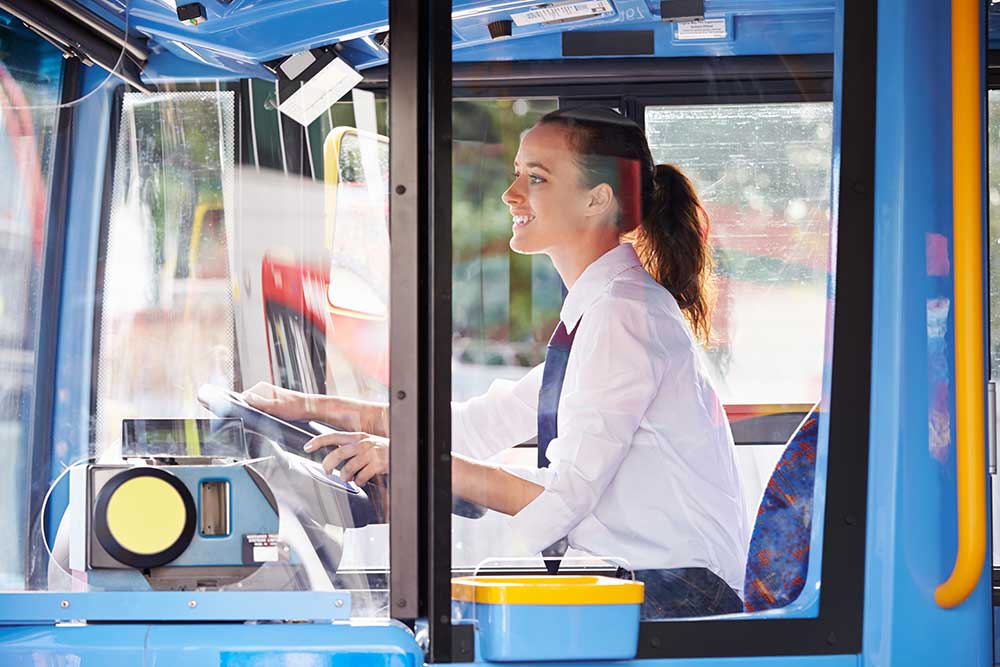Disclaimer: The information on our website is provided for general information purposes only. We make no representations or warranties of any kind, express or implied, about the completeness, accuracy, reliability, suitability or availability with respect to the website or the information contained on our website for any purpose. Any reliance on such information is therefore strictly at your own risk and we are not liable for any damages or losses arising out of or resulting from your reliance on any information contained on our website.
A transit bus driver takes passengers on regularly scheduled routes and ensures they reach their destination on time and safely. They may have titles that include the word charter or transit in their title. Such titles include bus operator, charter bus driver, transit operator, or coach operator for example.
Watch a video to learn more about what a transit bus driver does:
How to Become a Transit Bus Driver
Most transit bus drivers need at least a high school diploma and a safe driving record. From there, some employers may train you on-the-job as you gain the endorsements on your license to drive a transportation bus. Other employers may require you to have your license to transport people first. According to O*NET OnLine, a little over 80% of transit bus drivers have a high school diploma but a few reported holding the position without having earned their diploma.
According to the Department of Motor Vehicles, you’ll need to attain a commercial driver’s license (CDL) to drive a bus. There is a commercial learner’s permit that gives you the opportunity to practice driving the vehicle without passengers. Next, you would normally pass a written exam, have a history of safe driving, complete a road skills test in the vehicle you will be driving, and then apply for a CDL endorsement. Requirements do vary by state, so you would want to find out what your state’s requirements are.
Job Description of a Transit Bus Driver

A transit bus driver could work in a variety of settings in the transportation industry. For instance, they could work for a motorcoach tourism company and transport large groups of tourists from one location to another. These transit bus drivers may then also have the additional duties of pointing out significant points of interest along the way and providing education to the passengers on board. Other transport bus drivers could work for rental car companies transporting passengers at airports to the rental care location to pick up their car. These drivers may have an additional task of helping passengers loading their luggage on and off the bus.
No matter the setting a bus driver may work in though, safety is a priority. They must follow traffic laws and be diligent to react to any potential hazard en route to ensure passengers in their care have a safe ride. They may also have to perform scheduled inspections on their vehicle to ensure their oil and windshield wiper levels are full and ensure they always have enough gas. Some individuals may need assistance getting on and off the bus as well, especially if the bus has a few steps. They may help individuals that need some extra support on and off the bus.
Finally, bus drivers interact with passengers when they have questions or may even need to collect payment from passengers or check if they have tickets to board. It’s important that bus drivers remain professional and courteous. Sometimes, they may have to address a situation where a passenger is not behaving properly on the bus.
Transit Bus Driver Career Video Transcript
Whether they’re going to work or crossing the country, passengers depend on the skills and courtesy of bus drivers to get them where they need to go. Bus drivers transport people between locations in a city, and across state and national borders. They must drive through all types of weather conditions, handle passenger emergencies, and keep passengers safe, all while maintaining a schedule. Local transit bus drivers follow a daily schedule to drive passengers on regular routes in cities and suburbs. They may collect fares and issue transfers, and often answer questions about schedules and routes. Intercity bus drivers transport passengers between cities or towns, picking up and dropping off passengers at bus stations or downtown stops.
Charter bus drivers take passengers on trips or sightseeing tours. Motor coach drivers usually stay with the passengers for the length of the trip, and help passengers load and unload baggage. Most employers prefer a high school diploma or equivalent. Once hired, bus drivers get 1 to 3 months of training, starting on a driving course, then in light traffic, eventually taking practice runs on the type of route they’ll drive after training. Drivers may work nights and weekends. All bus drivers must have a commercial driver’s license (or CDL) with an endorsement for driving a bus… good hearing and vision… and a good driving record. Some employers offer the opportunity to earn a CDL on the job.
Article Citations
Bureau of Labor Statistics, U.S. Department of Labor, Occupational Outlook Handbook, Bus Drivers, Transit and Intercity and Bus Drivers.
National Center for O*NET Development. 53-3021.00. O*NET OnLine.
The career video is in the public domain from the U. S. Department of Labor, Employment and Training Administration.
State of California. Department of Motor Vehicles. Driver License (DL) and Identification (ID) Card Information.

